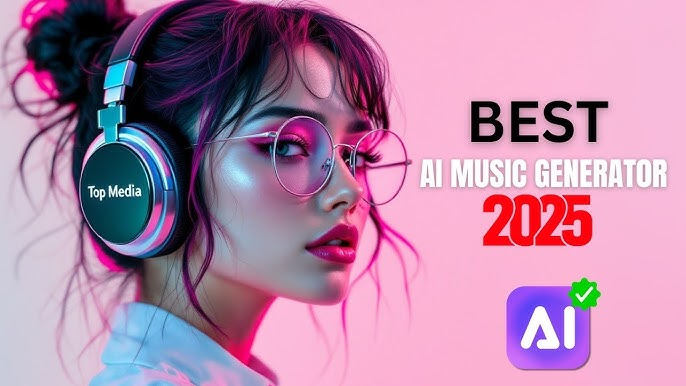Top 10 AI Tools for Music Generators in 2025
The music industry has witnessed an unprecedented transformation with the rise of artificial intelligence, fundamentally changing how we create, produce, and experience music. As we advance through 2025, the AI music generators 2025 landscape has evolved from experimental technology to sophisticated platforms that rival traditional music production methods. The convergence of machine learning, neural networks, and creative algorithms has birthed a new era where anyone can make music with AI, regardless of their musical background or technical expertise.
This revolutionary shift has democratized music creation, enabling content creators, indie artists, YouTubers, and businesses to produce professional-quality soundtracks without extensive musical training or expensive equipment. The AI music generators 2025 landscape is more diverse and powerful than ever, offering everything from simple beat makers to complex composition tools that can generate entire symphonies. These platforms have become essential resources for creators seeking to enhance their content with original music while avoiding copyright issues.
The market for AI-generated music platforms has exploded, with venture capital flowing into startups developing innovative solutions for music creation. Industry reports indicate that the AI music market is projected to reach $3.1 billion by 2028, driven by increasing demand from content creators, game developers, and advertising agencies. This growth reflects the technology’s maturation and its integration into mainstream creative workflows.
Modern AI music software leverages advanced neural networks trained on vast datasets of musical compositions across genres, styles, and cultural traditions. These systems can understand musical theory, recognize patterns, and generate compositions that maintain coherence and emotional resonance. The technology has progressed to the point where AI-generated music can be indistinguishable from human-created compositions, raising fascinating questions about creativity and authorship in the digital age. These platforms have become essential resources for creators seeking to enhance their content with AI music generators 2025 tools
1. Mubert – The Pioneer of Real-Time AI Music Generation

Mubert stands as one of the most established names in AI music generation, having pioneered the concept of real-time, adaptive music creation. This platform has revolutionized how businesses and creators approach background music, offering an endless stream of royalty-free compositions tailored to specific moods, activities, and contexts.
Mubert continues to lead the AI music generators 2025 market The platform’s strength lies in its ability to generate music that adapts to real-time parameters, making it ideal for applications requiring dynamic soundscapes. Mubert’s AI analyzes millions of audio samples contributed by artists worldwide, creating unique combinations that maintain musical coherence while ensuring originality. The system excels at producing ambient, electronic, and instrumental tracks perfect for streaming, meditation apps, retail environments, and content creation.
For content creators looking to create AI music for YouTube, Mubert offers seamless integration with video platforms, automatically generating soundtracks that match video duration and mood. The platform’s API capabilities make it particularly valuable for developers building music-integrated applications, providing programmatic access to its vast library of AI-generated compositions.
Mubert’s business model caters to various user segments, from individual creators seeking background music to enterprise clients requiring scalable music solutions. The platform’s subscription tiers offer different levels of access, from basic personal use to commercial licensing for major brands. This flexibility has made Mubert a go-to solution for businesses seeking consistent, high-quality background music without the complexity of traditional music licensing.
The platform continues to evolve, incorporating user feedback and advancing its AI algorithms to produce increasingly sophisticated compositions. Recent updates have improved the system’s ability to understand genre-specific nuances and create music that feels authentic to particular styles and cultural contexts.
2. MusicLM – Google’s Advanced AI Music Creator
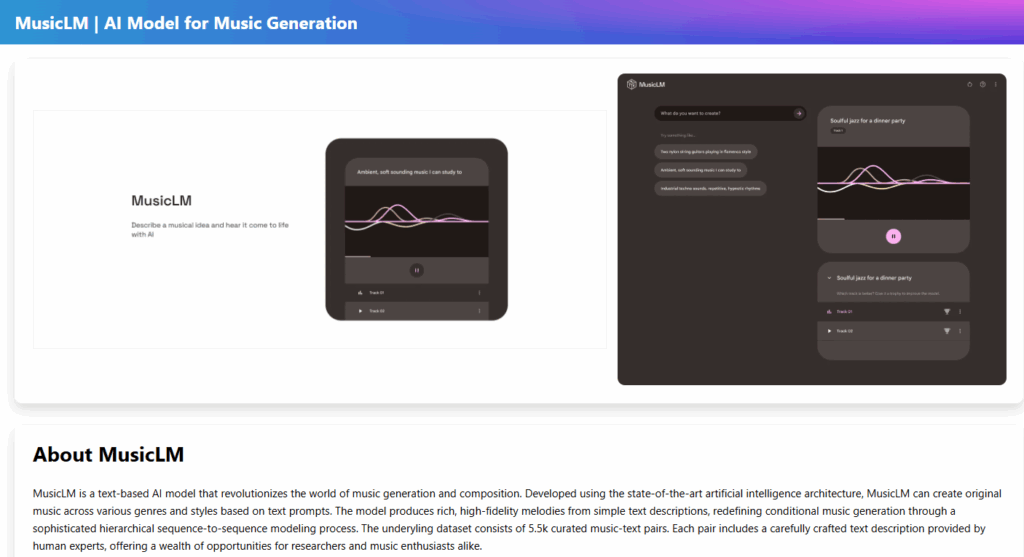
Google’s MusicLM represents a significant leap forward in AI music generation, utilizing the company’s extensive research in machine learning and natural language processing. This experimental tool demonstrates the potential of large language models applied to music creation, capable of generating high-quality musical compositions from text descriptions.
MusicLM’s approach differs from traditional AI music generators by focusing on understanding the semantic meaning of musical descriptions. Users can input complex prompts describing desired musical characteristics, emotions, instruments, and styles, and the AI translates these descriptions into coherent musical compositions. This natural language interface makes the tool accessible to users who may not have traditional musical vocabulary but can articulate their creative vision.
The system’s training encompasses an enormous dataset of musical recordings paired with descriptive text, enabling it to understand the relationship between linguistic concepts and musical elements. This foundation allows MusicLM to generate compositions that accurately reflect user intentions while maintaining musical integrity and emotional resonance.
What sets MusicLM apart is its ability to generate longer compositions while maintaining thematic consistency and structural coherence. The AI can create multi-minute tracks that evolve naturally, incorporating variations and developments that mirror human compositional techniques. This capability makes it particularly valuable for applications requiring extended musical pieces, such as film scoring or ambient music creation.
Google’s commitment to responsible AI development is evident in MusicLM’s design, with built-in safeguards to prevent the generation of copyrighted material and ensure ethical use of training data. The platform represents a glimpse into the future of AI music creation, where natural language becomes the primary interface for musical expression.
3. Udio – The Revolutionary AI Music Generator

Udio has emerged as a game-changer in the AI music generation space, offering unprecedented quality and versatility in AI-generated compositions. This platform has quickly gained recognition for its ability to produce professional-grade music across multiple genres, from pop and rock to classical and electronic music.
The platform’s strength lies in its sophisticated understanding of musical structure and genre conventions. Udio’s AI can generate complete songs with verses, choruses, bridges, and outros that feel natural and engaging. The system excels at creating vocal melodies, harmonies, and arrangements that rival human compositions, making it an invaluable tool for songwriters and music producers.
When comparing Suno vs Udio, users often highlight Udio’s superior audio quality and more intuitive user interface. The platform offers extensive customization options, allowing users to specify tempo, key, mood, and instrumentation preferences. This granular control enables creators to fine-tune their compositions to match specific requirements while maintaining the spontaneity and creativity that AI generation provides.
Udio’s approach to AI music generation emphasizes collaboration between human creativity and artificial intelligence. The platform encourages users to iterate and refine their compositions, using AI as a creative partner rather than a replacement for human input. This philosophy has resonated with professional musicians and producers who see AI as a tool for enhancing rather than replacing their creative process.
The platform’s commercial licensing options make it particularly attractive for businesses and content creators seeking original music for their projects. Udio’s clear licensing terms and high-quality output have made it a preferred choice for advertising agencies, game developers, and film producers looking for cost-effective music solutions.
4. Suno – The Comprehensive AI Song Generator
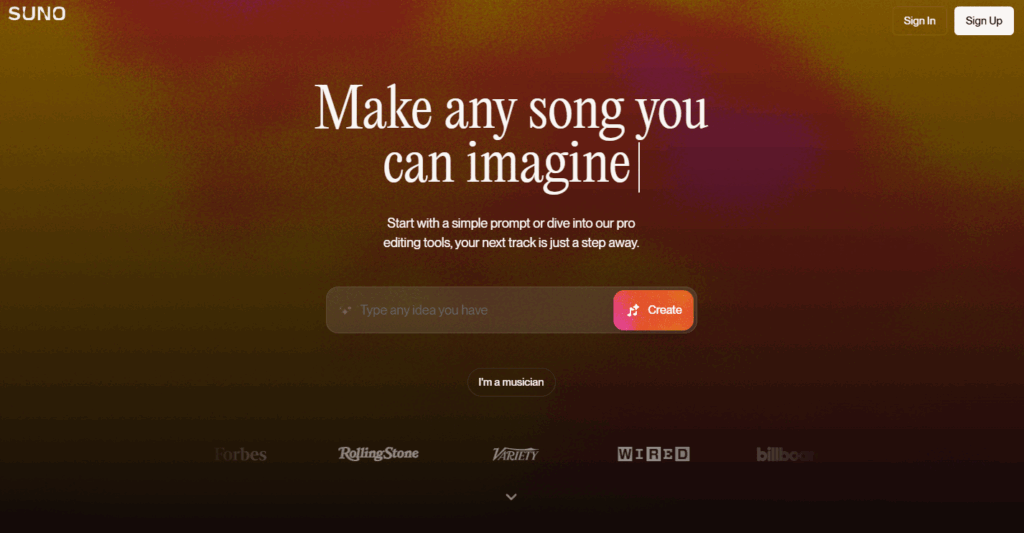
Suno has established itself as a comprehensive AI song generator that bridges the gap between simplicity and sophistication. This platform offers an intuitive interface that makes AI music creation accessible to beginners while providing advanced features for experienced users.
The platform’s AI demonstrates remarkable versatility in generating music across genres, from acoustic folk to electronic dance music. Suno’s strength lies in its ability to understand and replicate genre-specific characteristics while maintaining originality and creativity. The system can generate not only instrumental tracks but also complete songs with AI-generated vocals, making it a true ai song maker for creators seeking complete musical compositions.
Suno’s approach to user experience emphasizes ease of use without sacrificing quality. The platform offers guided creation processes that help users navigate the music generation workflow, from initial concept to final composition. This user-friendly approach has made Suno particularly popular among content creators who need quick access to high-quality music without extensive technical knowledge.
The platform’s subscription model provides excellent value for regular users, offering generous generation limits and commercial licensing options. Suno’s commitment to supporting independent creators is evident in its pricing structure, which makes professional-quality AI music generation accessible to individuals and small businesses.
Recent updates to Suno have introduced advanced editing capabilities, allowing users to modify generated compositions with precision. These tools enable creators to adjust specific elements of their music, from individual instrument levels to overall arrangement structures, providing greater creative control over the final output.
5. Soundraw – The Professional Music Generator Software

Soundraw represents the professional end of the AI music generation spectrum, offering sophisticated tools designed for serious music creators and businesses. This platform has gained recognition as one of the best music generator software solutions for users requiring high-quality, customizable compositions.
The platform’s strength lies in its granular control over musical elements, allowing users to adjust everything from chord progressions to individual instrument articulations. Soundraw’s AI understands complex musical relationships and can generate compositions that adhere to professional music production standards. This attention to detail makes it particularly valuable for film scoring, game music, and commercial applications where quality is paramount.
Soundraw’s interface caters to users with varying levels of musical expertise, offering both simple template-based generation and advanced customization options. The platform’s AI can generate music in specific time signatures, keys, and tempos, making it ideal for projects with precise musical requirements. This flexibility has made Soundraw a preferred choice for professional composers and music supervisors.
The platform’s licensing model provides clear ownership rights and commercial use permissions, addressing one of the primary concerns for professional users. Soundraw’s transparent approach to licensing has made it a trusted solution for businesses requiring original music for their projects without the complexity of traditional music licensing negotiations.
Recent developments in Soundraw include enhanced AI algorithms that better understand musical emotion and storytelling, enabling the generation of compositions that support narrative structures in film and video content. These improvements have expanded the platform’s applicability to a broader range of creative projects.
6. Musicfy – The AI-Powered Music Creation Platform
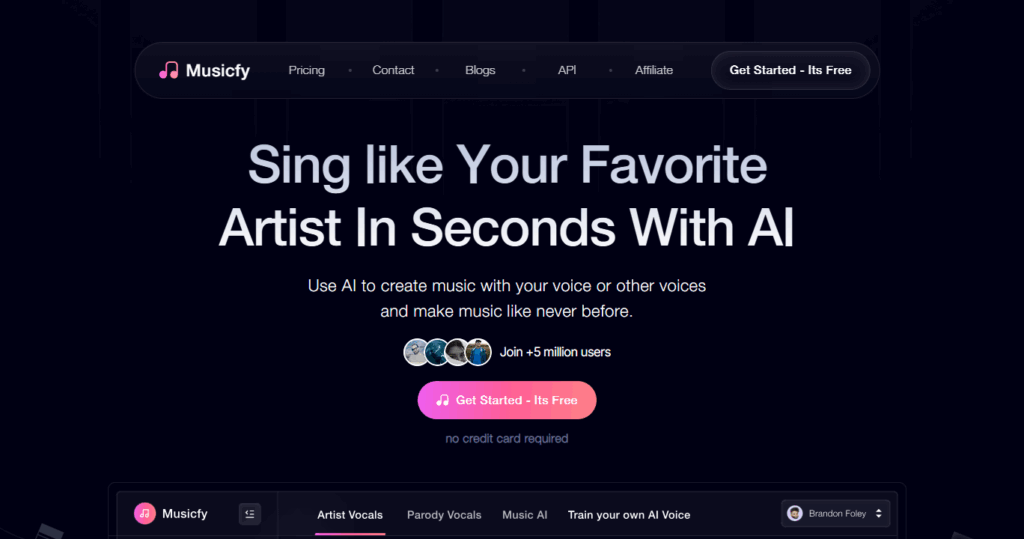
Musicfy has carved out a unique niche in the AI music generation landscape by focusing on user-friendly tools that democratize music creation. This platform combines advanced AI technology with intuitive design, making it accessible to creators regardless of their technical background or musical training.
The platform’s approach emphasizes rapid prototyping and iteration, allowing users to quickly generate musical ideas and refine them through successive iterations. Musicfy’s AI understands musical context and can suggest complementary elements, such as harmonies, rhythmic patterns, and instrumental arrangements that enhance the overall composition.
What distinguishes Musicfy is its community-driven approach to music creation. The platform encourages users to share their creations, collaborate on projects, and learn from each other’s work. This social aspect has created a vibrant ecosystem of creators who push the boundaries of what’s possible with AI music generation.
The platform’s mobile-first design makes it particularly appealing to creators who work on the go. Musicfy’s music generator app provides full functionality on smartphones and tablets, enabling users to create and edit music from anywhere. This mobility has opened new possibilities for spontaneous creativity and real-time collaboration.
Musicfy’s commitment to education is evident in its extensive tutorial library and learning resources. The platform provides guidance on both AI music generation techniques and fundamental music theory, helping users develop their creative skills while leveraging AI technology.
7. Riffusion – The Visual AI Music Generator
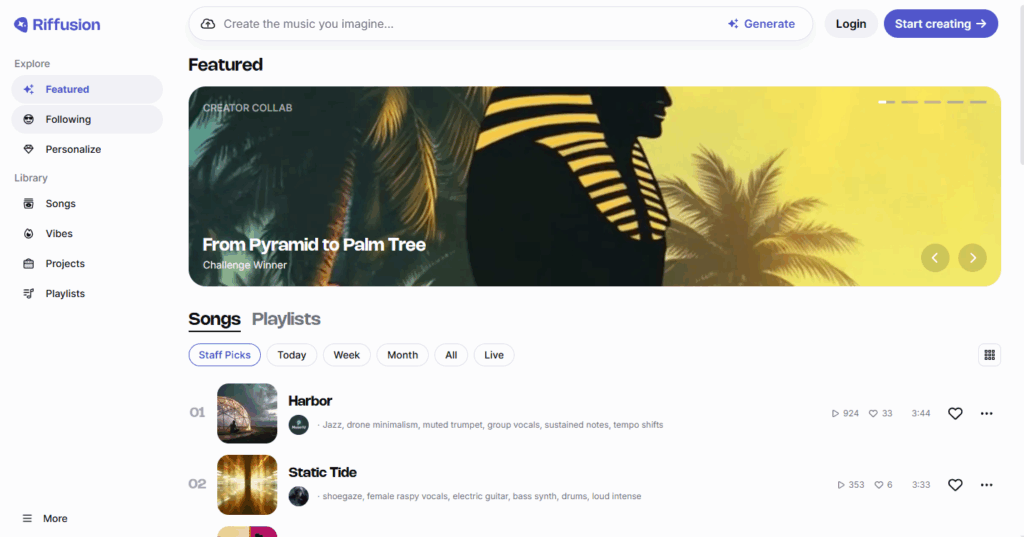
Riffusion introduces a unique approach to AI music generation by combining visual elements with audio creation. This innovative platform allows users to create music through visual interfaces, making the abstract process of music composition more tangible and intuitive.
The platform’s core innovation lies in its ability to generate music from spectrogram images, creating a direct visual representation of sound that users can manipulate and modify. This approach appeals to visually-oriented creators who find traditional audio interfaces challenging or limiting. Riffusion users appreciate the immediate visual feedback and the ability to “see” their music as they create it.
Riffusion’s AI demonstrates remarkable capability in translating visual patterns into coherent musical compositions. The system can interpret complex visual inputs and generate corresponding audio that maintains musical integrity while reflecting the visual characteristics. This technology opens new possibilities for synesthetic music creation and multimedia art projects.
The platform’s educational value extends beyond music creation, offering insights into the relationship between visual and auditory perception. Users can experiment with different visual patterns and observe how they translate into musical elements, providing a unique learning experience about the fundamental nature of sound and music.
Recent updates to Riffusion have expanded its capabilities to include real-time audio-visual synchronization, making it valuable for VJ performances and multimedia installations. These enhancements have attracted attention from experimental artists and technology enthusiasts exploring the intersection of visual and auditory arts.
8. Mureka – The Collaborative AI Music Platform

Mureka represents a new generation of AI music platforms that emphasize collaboration and community-driven creation. This platform combines sophisticated AI music generation with social features that enable creators to work together on musical projects regardless of their geographic location.
The platform’s AI excels at understanding collaborative contexts, helping multiple users contribute to a single composition while maintaining musical coherence. Mureka’s algorithms can analyze different contributors’ styles and preferences, suggesting ways to blend their inputs into unified musical works. This capability makes it particularly valuable for bands, production teams, and creative collectives.
Mureka’s approach to AI music generation emphasizes creative augmentation rather than replacement. The platform provides tools that enhance human creativity while preserving the personal touch that makes music emotionally resonant. This philosophy has attracted professional musicians who see AI as a valuable creative partner.
The platform’s project management features cater to professional workflows, offering version control, collaborative editing, and deadline tracking. These tools make Mureka suitable for commercial music production, where multiple stakeholders need to coordinate their efforts efficiently.
Mureka’s integration with popular digital audio workstations (DAWs) allows users to seamlessly incorporate AI-generated elements into their existing production workflows. This interoperability has made the platform popular among producers who want to experiment with AI while maintaining their established creative processes.
9. Laive – The Live Performance AI Music Generator

Laive represents the cutting edge of real-time AI music generation, designed specifically for live performance and interactive applications. This platform enables musicians and performers to incorporate AI-generated music into their live shows, creating dynamic and unpredictable musical experiences.
The platform’s real-time capabilities allow performers to influence AI music generation through various inputs, including MIDI controllers, audio signals, and even biometric data. This responsive approach creates a genuine collaboration between human performers and AI systems, resulting in unique musical moments that cannot be replicated.
Laive’s AI demonstrates exceptional ability to maintain musical coherence while adapting to rapidly changing performance contexts. The system can seamlessly transition between different musical styles, tempos, and dynamics based on performer input, creating smooth and natural-sounding musical evolution throughout a performance.
The platform’s low-latency processing ensures that AI-generated elements respond immediately to performer actions, maintaining the spontaneous energy that live music demands. This technical achievement has made Laive popular among electronic musicians, DJs, and experimental performers who push the boundaries of live music performance.
Laive’s educational applications extend to music schools and conservatories, where it serves as a practice tool for improvisation and ensemble playing. Students can use the platform to practice with AI-generated accompaniment that responds to their playing, providing valuable experience in musical interaction and adaptation.
10. MuseNet – OpenAI’s Sophisticated AI Composer
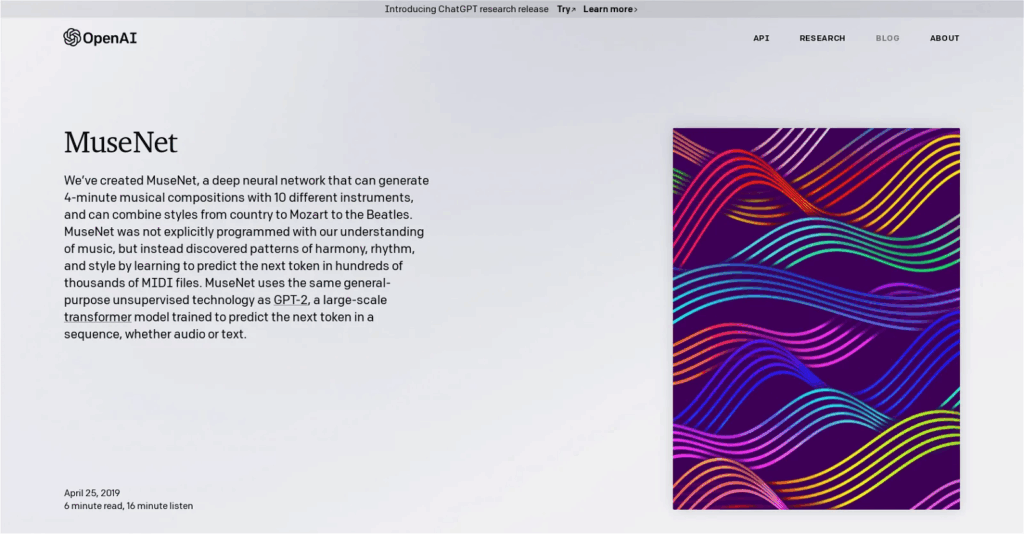
MuseNet is a standout name among the top AI music generators 2025 platforms, developed by OpenAI, represents one of the most technically advanced AI music generation systems available. This platform demonstrates the potential of large-scale neural networks to understand and generate music across multiple styles, instruments, and cultural traditions.
The system’s training on an enormous dataset of musical compositions enables it to generate music that spans classical, jazz, pop, rock, and world music genres. MuseNet’s ability to maintain stylistic consistency while creating original compositions has impressed both technologists and musicians, showcasing the potential of AI to understand complex musical relationships.
MuseNet’s approach to music generation emphasizes long-form composition, creating extended pieces that develop themes and motifs over time. The system can generate multi-instrument arrangements that demonstrate sophisticated understanding of orchestration and musical texture. This capability makes it particularly valuable for composers and arrangers seeking inspiration or starting points for their work.
The platform’s experimental nature reflects OpenAI’s commitment to advancing AI research while exploring creative applications. MuseNet serves as both a practical tool for music creation and a demonstration of AI’s potential to understand and generate complex artistic content.
Recent developments in MuseNet have focused on improving the system’s ability to respond to user input and generate music that matches specific requirements. These enhancements have made the platform more practical for commercial applications while maintaining its research-oriented approach to AI music generation.
Comparison Table: Top 10 AI Music Generators 2025
| Platform | Key Features | Best For | Pricing | Ease of Use | Commercial Use |
| Mubert | Real-time generation, API access, genre variety | Background music, streaming | Freemium, $14-199/month | Beginner-friendly | Full commercial rights |
| MusicLM | Text-to-music, long-form compositions | Experimental creation | Research preview | Moderate | Limited availability |
| Udio | High-quality vocals, genre versatility | Complete songs, professional use | Subscription-based | Intuitive | Commercial licensing |
| Suno | Comprehensive creation, vocal generation | Content creators, beginners | Freemium, $10-30/month | Very easy | Clear licensing |
| Soundraw | Professional quality, granular control | Film scoring, commercial projects | $19.99-49.99/month | Moderate to advanced | Full ownership |
| Musicfy | Community features, mobile-first | Collaborative projects, mobile users | Free tier, premium options | Beginner-friendly | Community guidelines |
| Riffusion | Visual interface, spectrogram editing | Visual artists, experimental music | Open source, free | Unique learning curve | Open licensing |
| Mureka | Collaboration tools, workflow integration | Teams, professional production | Subscription-based | Professional-oriented | Commercial rights |
| Laive | Real-time performance, interactive input | Live performances, interactive shows | Performance-based pricing | Advanced users | Performance licensing |
| MuseNet | Advanced AI, classical compositions | Research, classical music | Free research tool | Technical interface | Research purposes |
Frequently Asked Questions (FAQs)
Q: What is the best AI music generator for beginners in 2025? A: For beginners, Suno and Musicfy offer the most user-friendly interfaces with comprehensive tutorials and guided creation processes. These platforms provide excellent starting points for users new to AI music generation while offering enough features to grow with your skills.
Q: Can I use AI-generated music for commercial purposes? A: Most platforms offer commercial licensing options, but terms vary significantly. Soundraw and Mubert provide clear commercial rights, while platforms like MuseNet are primarily for research. Always review licensing terms before using AI-generated music in commercial projects.
Q: How do AI music generators compare to traditional music production? A: AI music generators excel at rapid prototyping, inspiration, and creating background music, but they currently complement rather than replace traditional music production. They’re best used as creative tools alongside human musical expertise and traditional production techniques.
Q: Are there completely free AI music generators available? A: Yes, several platforms offer free tiers with basic functionality. Riffusion is open source and completely free, while platforms like Mubert, Suno, and Musicfy offer free plans with limited features. MuseNet is also free for research purposes.
Q: Can AI music generators create music with vocals? A: Yes, several platforms including Udio and Suno can generate music with AI vocals. These systems can create both instrumental and vocal compositions, though the quality and naturalness of AI vocals continue to improve rapidly.
Q: What’s the difference between AI music generators and traditional DAWs? A: AI music generators focus on automated composition and creation, while DAWs (Digital Audio Workstations) are primarily recording and editing tools. Many creators use both together, generating initial ideas with AI and refining them in traditional DAWs.
Q: How realistic is AI-generated music compared to human-created music? A: Current AI music generators can produce remarkably realistic music that’s often indistinguishable from human compositions. However, they excel in certain areas (like background music and specific genres) while still developing in others (like complex emotional expression and narrative songwriting).
Q: Can I integrate AI music generation into my existing workflow? A: Yes, many platforms offer API access and integration capabilities. Mureka and Soundraw provide excellent workflow integration features, while platforms like Mubert offer API access for developers building custom applications.
The Future of AI Music Generation
As more creators turn to AI music generators 2025 platforms, the line between human and machine-made music continues to blur. The landscape of AI music generators 2025 continues to evolve at an unprecedented pace, with 2025 marking a pivotal year for the industry. As these technologies mature, we’re witnessing the emergence of AI tools that not only generate music but understand context, emotion, and artistic intent in ways that were previously impossible.
The integration of AI music generation into mainstream creative workflows is accelerating, with major streaming platforms, game developers, and content creators adopting these tools as essential components of their production pipelines. The technology’s ability to generate high-quality, royalty-free music at scale addresses one of the most persistent challenges in content creation while opening new possibilities for creative expression.
Looking ahead, we can expect continued improvements in AI music quality, with systems becoming increasingly sophisticated in their understanding of musical theory, cultural context, and emotional resonance. The convergence of AI music generation with other emerging technologies, such as virtual and augmented reality, promises to create entirely new forms of interactive and immersive musical experiences.
The democratization of music creation through AI tools is fundamentally changing who can participate in music making, breaking down traditional barriers of technical skill and expensive equipment. This shift is fostering a new generation of creators who combine human creativity with AI capabilities to produce innovative musical content.
As we progress through 2025, AI music generation will continue to evolve from a novel technology to an indispensable creative tool. Whether you’re a content creator seeking the perfect soundtrack, a musician looking for creative inspiration, or a business needing scalable music solutions, the AI music generation tools available today offer unprecedented opportunities to enhance your creative and commercial endeavors. The future of music creation is here, with AI music generators 2025 making it more accessible, diverse, and exciting than ever before.
